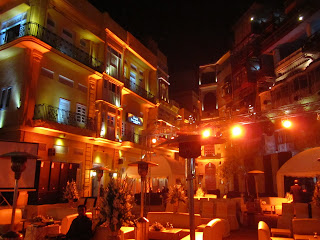 |
Me in Dai anga Mosque
Pics Credit Adil lahorei |
This Mughal mosque is situated in the Naulakha area, southeast of the fortress-like railway station. You can approach it from the railway station, but it might be simpler to travel northeast on Nicholson Road from Qila Gujjar Singh Chowk, and continue straight across Allama Iqbal Road (formerly Mayo Road), past the Presbyterian Church and Boharwala Chowk.

The comparatively narrow road veers left, terminating in a dead end at a gate guarding the railway platform beyond the fence.
On the left is a gate behind which is situated a mosque built by Dai Anga Zeb-un-Nisa, a wet nurse of Emperor Shah Jahan. Her family had been closely associated with the Mughal imperial family her husband Morad Khan served Jahangir as Adawlati or Magistrate of Bikaner, and her son Muhammad Rashid Khan, reputed to be one of the best archers in the kingdom, died fighting in the service of Shah Jahan's eldest born Dara Shikoh. Zeb-un-Nisa herself was highly regarded by Shah Jahan.
Passing through the gate one is overawed by the magnificent structure of Dai Anga's mosque. Although a lot of restoration work has been carried out on the building—much appears to belong to later-period restorative efforts—it cannot take away from the magnificence of the original structure.
The design of the mosque is based on a single-aisle 3-bay plan form—a comparatively simplified version of the spectacular mosques built by the Mughals. The prayer chamber is divided into three compartments by means of lateral arches. The central bay, larger than the others, has exceptionally rich decoration. The usual arched recess sunk deeply into the western wall serves as the mihrab. It is crowned, like its flanking counterparts, with a high double dome placed on squinches composed of eight small arched panels. The side bays, less elaborately decorated, have double domes resting on pendentives. The central compartment has a pronounced projection created by means of an engrailed arch and a half-dome embellished with tiled panels. The projected frame is marked with slender pilasters on either corner, while at the two eastern corners of the prayer chamber are square minarets surmounted with a carved platform on which once rested the kiosk.
The exterior surface of the projection, as well as the flanking compartments, have been divided into numerous decorative panels of various shapes, sizes, and designs and filled with fluoridate patterns created by means of mosaic kashi. The dominant colours used in the tilery, here as well as in the interior panels, are blue, orange, and yellow. The treatment of facade into panels, embellished with scintillating multicoloured tile mosaic, a favourite decorative medium during Shah Jahan's days, yields one of the most spectacular facades of the period. The domes are plastered, but possess pronounced cavettos, reminiscent of similar treatment at the Moti Mosque of Lahore Fort. A 19' diameter dome in the middle flanked by two 16' domes, along with corner minarets, adds to the imposing character of the mosque. The central lofty Timurid aiwan alcove, flanked by two smaller ones, as embellished as the facade, along with their decorative kalib kari or stalactite squinches represent the best of the Shahjahani Period.
The tall minarets rising from a square base on the two front extremities are terminated with kiosk-like structures carrying cupolas. Although simply treated today, they were no doubt once decorated with tile mosaic in the manner of those found in the mosque of Shah Jahan's grandee, Wazir Khan. The 84' wide platform, no doubt once part of the mosque courtyard, is paved with beautifully laid brick flooring divided into a simple square pattern. Within the courtyard in which the building stands, an ablution tank has been found, and traces exist of what may prove to be a second tank.
It is believed that the mosque was built in 1045 AH/1635 AD, before Dai Anga went to perform Hajj. However, the inscription in the mosque is said to date it to 1060 AH/1649 AD. The mosque was well-maintained and frequented by worshippers, due to the waqf (bequest) by Dai Anga of her extensive property for the maintenance of the mosque. Once the Mughal Empire declined, this mosque, along with many other Mughal monuments, did duty as Ranjit Singh's military magazine. After the annexation of the Punjab by the British, Henry Cope, editor of the newspaper 'Lahore Chronicle' must have been pleased to have been allowed its use as his residence. However, later when the area, once known as Mohallah Dai Anga and populated by Mughal nobility, was acquired by the Punjab and Delhi Railway Co., Cope sold the mosque-residence to them for Rs. 12,000, and they converted it into the office of the traffic manager, Punjab Northern State Railway.
After Lord Curzon expressed his horror at the debased usage many of the historic monuments had been put to, in 1903 Dai Anga's mosque was returned to the Muslims of Lahore. if u have intend to see more pics of Mosque of lahore then then visit
Mosque of Lahore



































